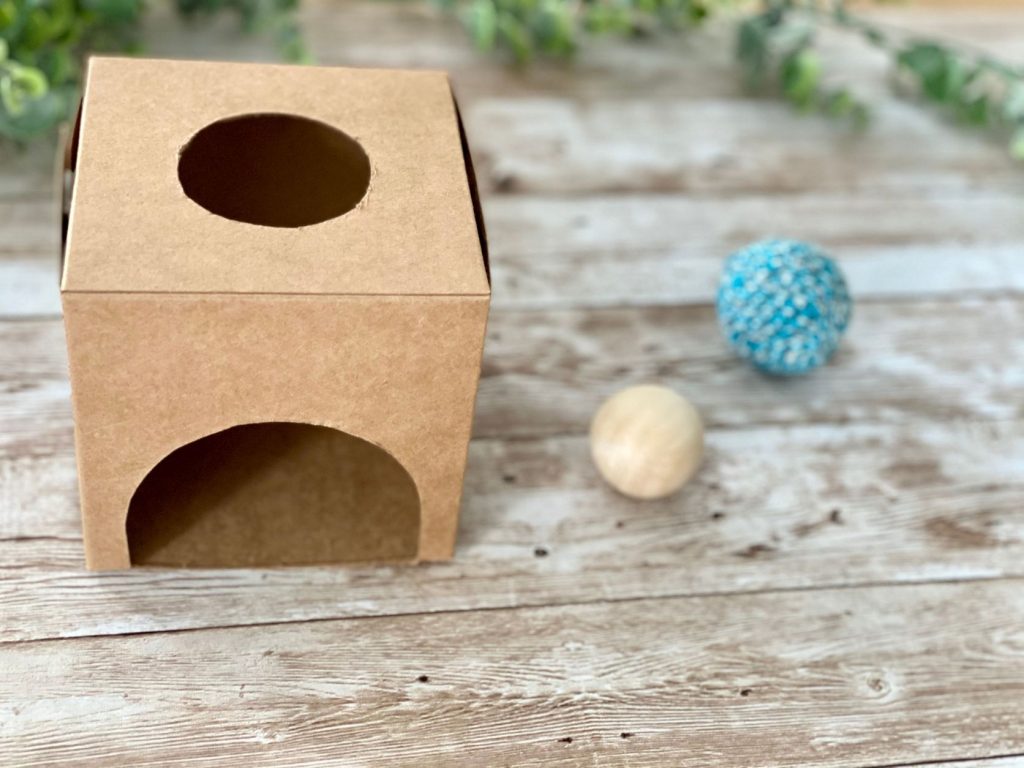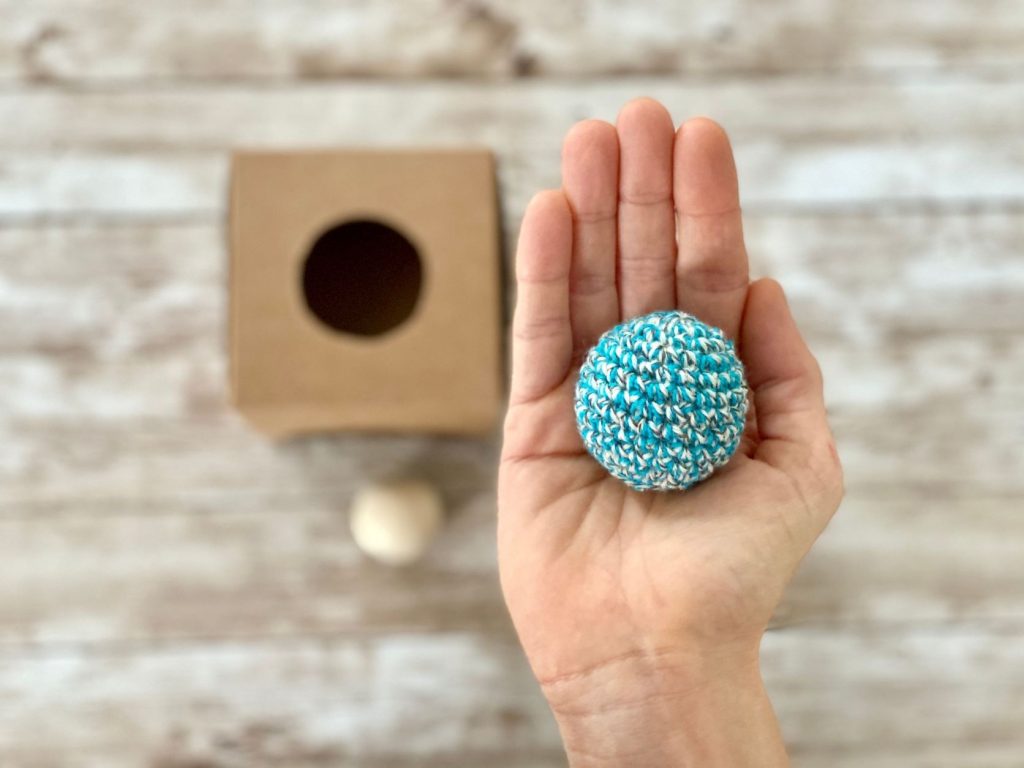Have you noticed that every time you leave the room your 6-month-old (or around there) baby gets distressed and works himself up into almost a panic mode? Has s/he started to ‘accidentally’ drop things from the high chair and watch you putting it back over and over again? Has s/he started putting a smaller item into a bigger one? If your answer is YES to any of the above, then your little one is cognitively ready to learn about Object Permanence, that things continue to exist even after disappearing from sight. This is a very important milestone in baby development and the Montessori Object Permanence Box is just the right material to help with this. Let’s have a look at it in more detail.
THE CONCEPT OF OBJECT PERMANENCE
It was Jean Piaget, a Swiss psychologist, who came up with the theory of cognitive development for babies. According to him, Object Permanence is a significant milestone. In order for a few months old child to understand that objects keep existing even after we cannot see (or hear, or feel, or sense it in any other way), babies need to have a mental picture of the object. To achieve this, they use all their senses and need concrete, real-life experience with the item. If you’d like to read more about this subject, read this blog.
WHY IS THIS CONCEPT SO IMPORTANT FOR BABIES TO LEARN?
A great proof of the fact that Object Permanence is still in development is that when the cup falls, your little one doesn’t actually watch it fall. From their perspective, it simply ceases to exist. Babies have to repeatedly experience the concept again and again in order to understand the relationship between the cause and effect. ‘If I drop the cup from the high chair, it disappears, but Mummy will make it appear again.’
It is only one small mental jump from here to watch you leave the room and worry whether you’ll come back at all. Or when you leave your baby in the nursery in the morning, they worry that you might not come back later for them. Now we can understand why they don’t want to let us out of their sight!
If you’d like to know more about object permanence, read this blog.
WHAT DOES THE MONTESSORI OBJECT PERMANENCE BOX LOOK LIKE?
As with every other Montessori material, the concept is extremely simple. There’s a box with a hole on top and a window on the side. All you have to do is to get a ball and drop it in the hole, which will roll out of the window in a matter of seconds. That’s it!
It’s actually quite funny watching babies working through the concept of the Object Permanence by dropping the ball again. And again. And again. All this with such single-minded focus that they might not even react when you talk to them!

SO WHY IS THE MONTESSORI OBJECT PERMANENCE BOX SO ATTRACTIVE FOR YOUR BABY?
The single most important secret of the effectiveness of the Box hinges on YOU! Every single Montessori material was made to be used at the right age at the right time. What does this mean? That if your baby is not yet interested in learning this concept, s/he will not pay any attention to it. However, if you catch the right moment, it will literally keep their curious little mind and hands occupied for hours (not in one go).
In order to be able to do this seemingly simple but in reality very complicated activity, babies need a lot of work. First of all, they have to be able to sit confidently to be able to focus all their attention on this activity. They have to be able to pick up a ball and place it into a relatively small hole. This needs concentration, observation, body control, precise movements, hand-eye coordination and logical thinking skills, just to name a few.
Every child develops at a different pace and the pace of development is not the same in each learning area. Some babies focus more on language development, some on social interactions, others on physical. Eventually they will all get to the same point, of course. Your job is to observe your baby and offer the right material and the right time to best help.
WHAT ARE THE SCIENTIFIC BENEFITS OF THE MONTESSORI OBJECT PERMANENCE BOX?
- Strengthens hand muscles
- Helps to gain finger dexterity and coordination across the body
- Assists in making controlled, voluntary movements in the hands
- Stimulates fine and gross motor skills
- Provides new sensory experiences
- Allows for exploration of the relationship between cause and effect
- Makes purposeful movements and planned actions
- Develops hand-eye coordination
- Helps visual development (tracking moving objects)
- Satisfies babys’ need to explore a concept by themselves
- Promotes logical thinking
- They transfer an object from one hand to another
- Passing an object encourages passing the middle line of the body…
- Which in turn stimulates both sides of the brain
- Being able to use it to its purpose raises self-esteem

TIPS AND TRICKS
The Object Permanence box is just the first material in the long line of posting activities. As your baby’s fine motor skills get better and better, change the activity around.
First I would offer only one ball to make sure your baby focuses on the drop, not on the catching of the rolling ball. When s/he’s confident with one, try it with two balls.
Cut different shapes in the box. Let’s not get stuck at the ’round only goes into the round hole’ and take it a step further. Make a square or an oval shape and see how your baby reacts! Pay attention that the ball easily drops into the hole.
Use a variety of balls! In my DIY Object Permanence kit you’ll find two different types of balls, one heavy and smooth, the other light and textured. Try the same activity with a tennis or a pingpong ball to enrich the activity.
FINAL THOUGHTS
Understanding object permanence is one of those baby milestones that, even though our society doesn’t give as much value as speaking or walking, has a huge impact. The Montessori Object Permanence Box is a great tool to learn the concept, which your little one will be able to apply to other experiences as well, such as playing peek-a-boo. You can introduce it to your baby around 6 months of age or when you see the signs that s/he’s ready for it. Go and have fun! And if you’re still wondering about whether you should buy it or DIY it, read through this post.
Click here to read more about how the Montessori Visual Mobiles, the Montessori Tactile Mobiles or the Sensory Baby Toys help your baby’s development.
How did your baby react to this material? Please share your photos on my Instagram site. #montessoriedited, @montessoriedited
